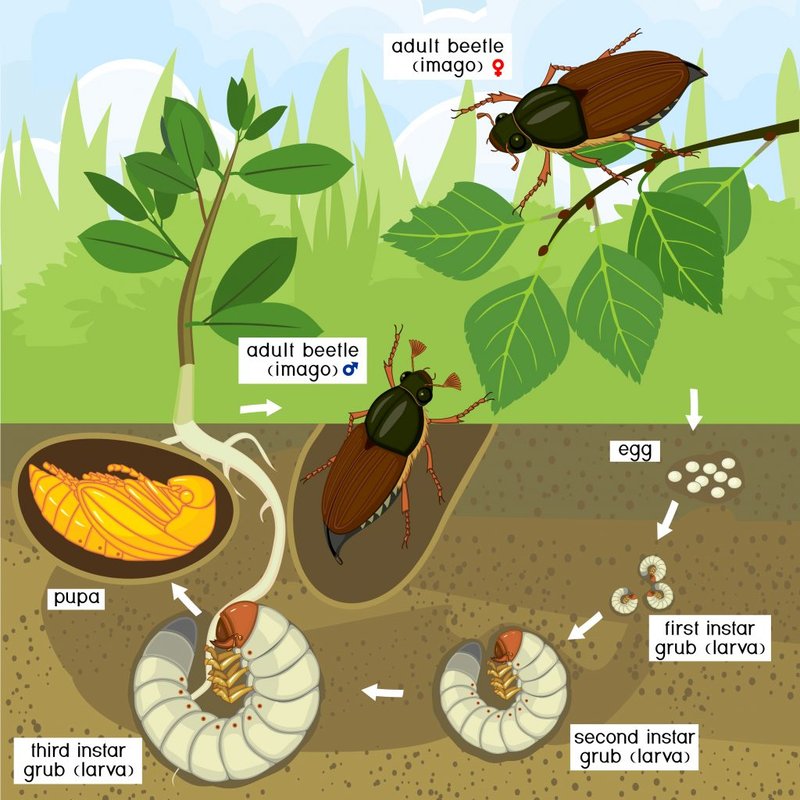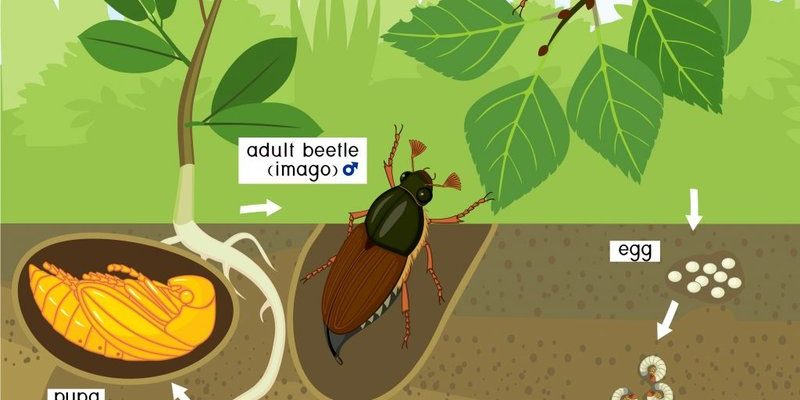
So, how do you kick these unwanted garden guests to the curb? Well, it starts with a solid seasonal grub worm control schedule. Managing these critters isn’t just about using products; it’s about timing and understanding when they’re most active. Let me walk you through everything you need to know to keep your yard healthy and grub-free.
What Are Grub Worms?
Grub worms are the larvae of various beetles, with the most common culprits being Japanese beetles and European chafers. They thrive in the soil, munching on the roots of grass and plants, which can severely damage your lawn if left unchecked. Picture your lawn as a delicious cake—grub worms are like the kids who sneak into the kitchen and take big bites out of it when no one is looking.
You might be wondering, “How can I tell if I have a grub worm problem?” One of the easiest signs is the health of your lawn. If you notice patches of grass that are yellowing or wilting despite watering, check for grubs. You can do this by pulling back some grass; if you see more than 10 grubs per square foot, it’s time to take action.
Understanding the Life Cycle of Grub Worms
To effectively manage grub worms, it helps to know their life cycle. Grub worms go through several stages—from eggs to larvae and eventually into adult beetles. Here’s how it generally works:
1. **Egg Stage**: In late spring or early summer, female beetles lay eggs in the soil.
2. **Larvae Stage**: The eggs hatch after about two weeks, and grub worms emerge, feasting on grass roots as they grow.
3. **Pupal Stage**: After feeding for several weeks, they burrow into the ground to pupate.
4. **Adult Stage**: In late summer to early fall, the mature beetles emerge, ready to start the cycle all over again.
So, when you’re thinking about your seasonal grub worm control strategy, timing your interventions is crucial. If you act during the **larvae stage**, you can prevent a bigger problem later on.
Spring Grub Control: Early Detection and Prevention
Spring is the time to be proactive with your grub worm control. Think of it as setting the stage before the drama unfolds. Early detection is key, as grubs are often easier to manage if you catch them before they lay eggs.
1. **Regular Lawn Inspections**: Take a walk around your lawn and look for signs of grub damage. Pay special attention to areas that look stressed or unhealthy.
2. **Soil Testing**: A soil test can give you insight into your lawn’s condition, making it easier to decide what treatment to apply. If your soil is healthy, it may naturally fight off pests better.
3. **Preventative Treatments**: Apply preventive insecticides in early spring before the beetles lay their eggs. Products containing **neonicotinoids** are commonly used at this stage.
By taking these steps in the spring, you can set yourself up for a more vibrant lawn later in the summer.
Summer Control: Monitoring and Direct Treatment
As summer heats up, so do the activities of grub worms. If you skipped the preventative treatments in spring, now’s the time to strategize. It’s like a second chance to save the day!
1. **Monitor for Damage**: Keep an eye on your lawn. If you notice areas that look distressed, it might be time to take action. Areas of grass that pull up easily, often referred to as “spongy,” can indicate a grub infestation.
2. **Direct Treatment**: If you find grubs, there are several treatment options. Chemical treatments work effectively, but you can also explore organic options if you prefer a less chemical-intensive approach.
3. **Water Wisely**: Grubs thrive in moist environments, so adjust your watering schedule. Deep watering can help your grass recover, but avoid over-watering, which might create a perfect home for grubs.
Staying vigilant in the summer can save your lawn from serious damage, and nobody likes a sad lawn.
Fall Maintenance: Preparing for the Next Season
As summer fades and fall approaches, it’s easy to think your work is done, but don’t let your guard down quite yet. Fall is an essential time for maintaining a healthy lawn and preventing future infestations.
1. **Final Lawn Check**: Assess your lawn for any signs of grub damage before the ground gets too cold. Early detection now can prevent bigger problems next spring.
2. **Aeration and Overseeding**: Aerating your lawn allows more water and nutrients to reach the roots. This strengthens your grass, which makes it more resilient against pests.
3. **Fall Treatments**: Use a preventative insecticide again in the fall to target any remaining grubs before they settle in for winter.
By taking these steps in the fall, you’ll give your lawn a fighting chance against grubs next season.
Know Your Control Products
When it comes to choosing products for grub worm control, you’ve got options. Here’s a quick rundown of the most common types, so you can find what works best for you.
- Chemical Insecticides: These are effective for immediate control. Look for products with ingredients like imidacloprid or chlorantraniliprole.
- Biological Controls: These are more eco-friendly and use natural predators or pathogens to control grub populations. Products containing nematodes are popular.
- Organic Solutions: There’s a variety of natural solutions available, like diatomaceous earth, which can deter grubs without harsh chemicals.
Before using any product, be sure to read the label and follow directions carefully. Proper application is key to effectiveness.
Keeping your lawn healthy and grub-free is a year-round commitment. By creating a seasonal grub worm control schedule, you’re setting yourself up for success. Remember, a little vigilance during spring, summer, and fall can go a long way.
So, grab your tools and get ready to tackle those pesky grubs head-on! You’ve got this! Whether it’s performing regular inspections, treating your lawn, or simply enjoying the outdoors, your hard work will pay off with a lawn that’s the envy of the neighborhood. Happy gardening!

